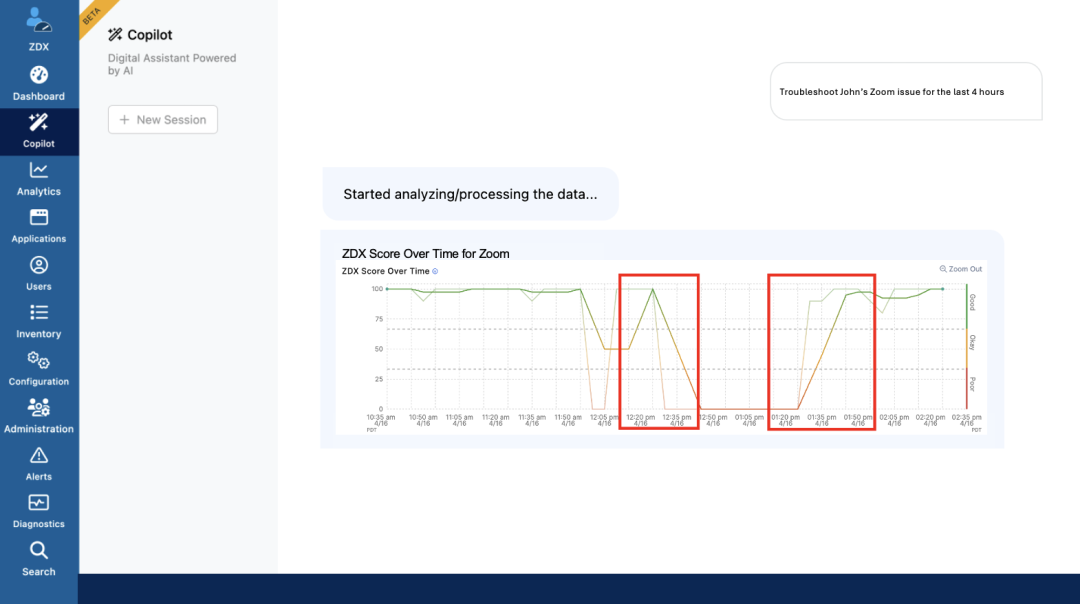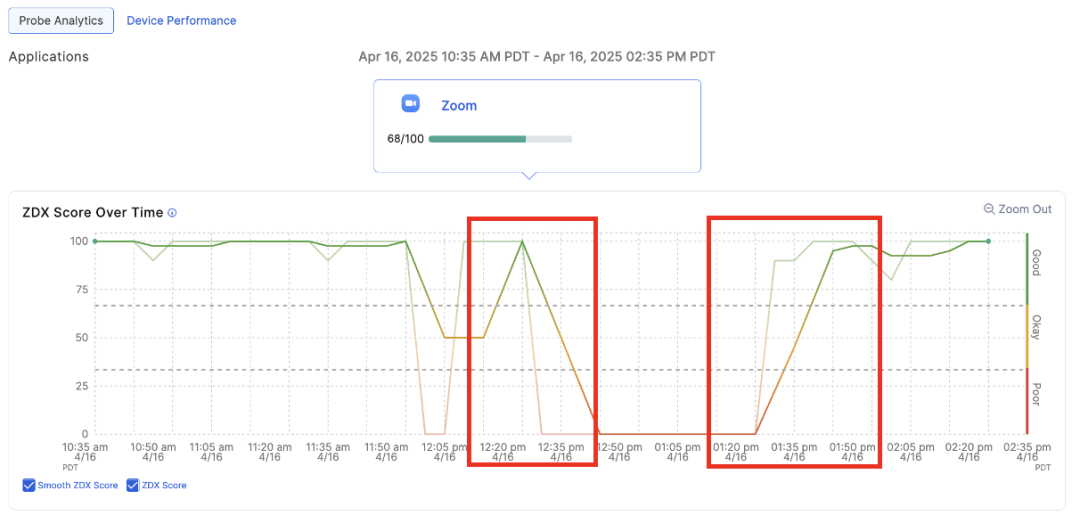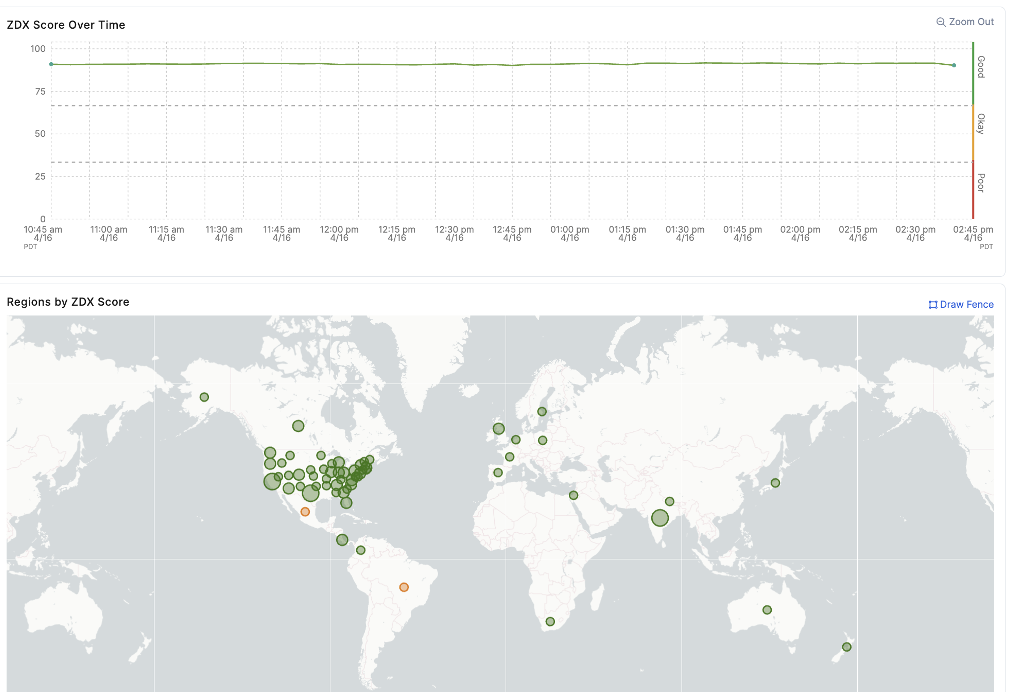When a Platform Goes Dark, the Cost Adds Up–Fast
On April 16, Zoom experienced a nearly two-hour service disruption due to a registry block affecting its core domain. While outages like this can happen to any SaaS provider, the impact on enterprise productivity is immediate and costly. Based on Gartner’s average downtime estimate of $5,600 per minute, a typical organization could lose over $600,000 during a disruption of this scale.
This isn’t just a Zoom issue—it’s a visibility issue. Most IT teams don’t have real-time insight into how key applications are performing across their distributed workforce. Without clear data, users are left in the dark, and IT is forced to play catch-up. That’s why it’s critical to have digital experience monitoring in place—not just for one app, but across the suite of tools your teams rely on every day.
Seeing the Problem Is One Thing. Solving It Fast Is Another.
Digital Experience Monitoring tools like Zscaler Digital Experience (ZDX) go beyond basic uptime checks. When a service like Zoom becomes unavailable—whether globally or just for a specific region or ISP—ZDX uses AI-powered root cause analysis to instantly pinpoint the source of the disruption. Device misconfiguration? Local network degradation? External app outage? ZDX gets to the answer in minutes, not hours.
But visibility alone isn’t enough. That’s where Zscaler Copilot changes the game. It enables IT and help desk teams to ask natural language questions—like “Why can’t users in Chicago access Zoom?”—and get immediate, actionable insights. No need to dig through logs or dashboards.
This capability is especially powerful at Level 1 support, where most IT tickets begin. Instead of escalating every unknown issue to L2 or L3 teams, L1 support can use Copilot to triage and resolve problems on the spot.
Let’s explore how the Zscaler Copilot came to the rescue during this incident.
Zscaler Copilot: Instantly Identifying Zoom Issues
Imagine you're the IT lead tasked with troubleshooting Zoom for John, an employee reporting issues over the past 4 hours. Instead of digging through logs or manually cross-referencing events, Zscaler Copilot makes the process effortless.

Zscaler Copilot instantly identifying the outage through natural language
With a simple prompt like, “Troubleshoot John’s Zoom issue for the last 4 hours,” Copilot leverages ZDX’s powerful AI capabilities to run an instant check, analyzing all potential factors affecting John’s performance. In seconds, Copilot highlights everything from network health to application-level indicators, pinpointing the root cause of the disruption.
This ability to ask natural-language questions reduces troubleshooting time and allows IT teams to proactively address issues before they escalate.
The ZDX dashboard provided IT teams with the ability to quickly identify Zoom as the root cause of the disruption, ensuring internal resources were not wasted on misdirected troubleshooting efforts.
By issuing a straightforward prompt like “Troubleshoot John’s Zoom issue for the last 4 hours,” Copilot taps into ZDX’s advanced AI capabilities to perform an instant analysis, evaluating all possible factors impacting John’s performance. Within seconds, Copilot identifies key issues ranging from network health to application-level metrics, pinpointing the exact cause of the disruption.
This natural-language interface streamlines troubleshooting, significantly reducing resolution time and enabling IT teams to proactively mitigate problems before they escalate.
Using the ZDX dashboard, IT teams efficiently determined that Zoom was the source of the issue, ensuring internal resources were not wasted on unnecessary troubleshooting efforts.

ZDX dashboard indicating Zoom issues
Proactive Monitoring with Intelligent Insights
Diving deeper into the Zoom issue, ZDX quickly pinpointed the root cause as a DNS problem within Zoom's infrastructure. Because this was a DNS-related issue, active Zoom meetings were unaffected and continued to maintain a strong ZDX score. These valuable insights empowered customers to confirm the problem was specific to Zoom, allowing their IT teams to focus on other critical services and avoid wasting time on unnecessary troubleshooting.

ZDX DNS analysis identifies the Zoom application issue in minutes

Zoom meetings that were already in progress continued without interruption.
By isolating the Zoom outage, IT teams avoided unnecessary escalations, reduced downtime, and maintained operational efficiency—continuing to ensure a seamless user experience for all other applications.
Improving the Confidence and Effectiveness of IT Teams
ZDX allows IT teams to quickly and confidently identify the source of an issue, saving valuable time and resources. This reduces mean time to diagnosis (MTTD) and mean time to resolution (MTTR) and allows organizations to minimize disruptions, improve user productivity, and maintain trust with employees and stakeholders.

Don’t Wait for the Next Outage
UCaaS disruptions will happen. The question is whether your organization will be ready. Now is the time to invest in AI-powered digital experience monitoring and support automation that keeps your users productive, your support team effective, and your costs under control.
The Zoom outage is just one example of how ZDX simplifies IT challenges, turning complex outages into manageable events. Whether it's Zoom, Microsoft Outlook, or another critical application, ZDX ensures IT teams are informed, proactive, and always a step ahead.
Get in touch with us today or explore Zscaler Digital Experience via the ZDX Playlist on YouTube or the zscaler.com/zdx page. See how ZDX and Copilot can revolutionize your organization’s approach to performance management and user experience.




